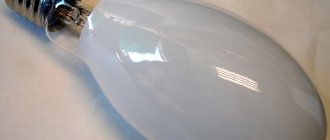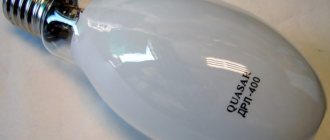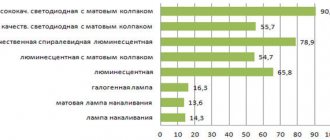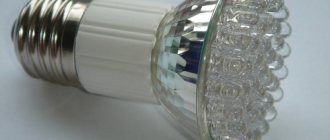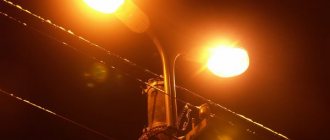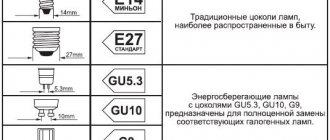DRL lamps, which are still actively used today, belong to gas-discharge lighting devices. Their distinctive feature is rich luminous flux and durability. Due to the mercury content, these products are used to organize artificial lighting of streets and industrial areas. But certain technical and operational nuances do not allow them to be used in domestic conditions. In the article we will look at what a DRL gas-discharge lamp is, how it works, the principle of its operation and where it is used.
What it is
The names of lamps usually indicate the type of light source. A specialist who understands labeling will quickly determine the parameters and operating principle of the device.
The decoding of the DRL is as follows:
- D - the electric arc formed when voltage is applied to the contacts leads to the ignition of the lamp. The design involves a choke, the task of which is to limit operating currents within specified limits;
- P - the device operates using mercury vapor;
- L - operating principle of the light source. The phosphor, which provides the luminescence process, converts ultraviolet light into the visible spectrum of radiation.
This is what the product looks like.
Additional information! When external energy is applied to a material, the light emitted begins a glowing process called luminescence.
The variety closest to DRL is DRV (mercury-tungsten). They are similar in design and principle of operation. Only in addition to the mercury discharge torch, a tungsten spiral is also installed, the task of which is to limit the strength of the current supplied to the burner. Accordingly, such lamps do not require additional ballasts.
Unlike DRL, DVR lamps:
- consume more electricity;
- work for approximately 3000 hours;
- light up for no longer than one minute.
Other “close” types are DRI and HPS bulbs.
Size depends on power characteristics
Selection criteria: assessment of technical indicators
When determining the optimal lighting fixture, you should take into account the following characteristics:
- power;
- shape/size of the base;
- luminous flux brightness;
- duration of work.
Power. When choosing this option, you should focus on the purpose and location of the lamp. If a device is purchased to illuminate the road, then you need to take into account the distance between the lamps - the greater it is, the more efficient the lamps should be.
The range of power characteristics of DRL illuminators is in the range of 80-1000 W. This value is displayed in the lamp markings, for example, DRL 250, DRL 400, etc.
Light flow. The main indicator of light radiation directed in different directions. The parameter is measured in lumens (Lm). It is by this criterion, and not by power, that it is necessary to compare the performance of different types of lamps.
Lamps with a DRL lamp consume more electricity to produce the required luminous flux than their LED counterparts and DNAT illuminators. The brightness of an LED device of 100 W corresponds to the illumination indicator of its mercury-arc counterpart of 400 W
Significant savings on energy resources are a strong argument in favor of LEDs. The high cost of LED lamps pays off in the first year of operation.
Base. DRL illuminators are available with the two most popular types of bases:
- E27 – screw shape, diameter – 27 mm. Mercury-arc devices of 80 W and 125 W are equipped with this base.
- E40 is the largest size in the “E” category. The 40 mm base is used in lamps rated at 250 W and above, intended for lighting large areas.
In addition to the type of screwing into the socket, you should also take into account the dimensions of the lamp shade.
The width and length of the gas discharge lamp depends on the power of the device. The higher the performance of the DRL illuminator, the larger and heavier it is
Duration of service. This parameter is largely determined by the quality of workmanship, namely the responsibility of the manufacturer. It is better to choose lamps with a maximum service life. As a rule, high-power devices have a longer service life.
For clarity, the general characteristics of lamps of different powers are shown in the summary table. All electrical appliances operate on alternating current, the standard frequency is 50 Hz
Some information about the characteristics of lamps is included in the labeling. In domestic practice, the letter abbreviation denotes the name of the illuminator, and the digital abbreviation denotes power. The production of mercury lamps is regulated by GOST 27682-88 and GOST 53074-2008.
Foreign products of the DRL type are marked QE according to the international ILCOS system. Some manufacturers adhere to the pan-European ZVEI and German LBS designation order.
Markers for mercury lamps from popular companies:
- HPL – Philips;
- HRL – Radium;
- MBF – General Electric;
- HQL - Osram;
- HSL and HSB – Sylvania.
Additional designations according to ILCOS: QB – models with built-in ballast, QG – spherical bulb, QR – lamps with a reflective inner layer.
Advantages and disadvantages
Arc mercury fluorescent light sources, including lamps, have the following advantages:
- high degree of luminous flux;
- serve for a long time;
- suitable for lighting at sub-zero temperatures;
- thanks to the built-in electrodes, they do not require an additional ignition device;
- available ballasts.
There are also a number of disadvantages, some of which impose restrictions on the scope of application:
- as GOST states, mercury and phosphor contained in these lamps must be disposed of using a special technology;
- low color rendering (about 45%);
- A stable voltage is required for full operation. If it drops to 15%, the lamp with such a light bulb will stop shining;
- at too low temperatures (more than −20 degrees Celsius), the light source may not light up. In addition, such operating conditions significantly reduce the service life of the lamp;
- to turn on the lamp again, you must wait 10 to 15 minutes;
- decrease in luminous flux after approximately 2000 hours of service.
You may be interested in this Features of fluorescent lamps
As a rule, the manufacturer specifies a number of rules that should be followed when operating these light sources. This will allow them to last longer. Even if the lamp is installed in the wrong position, its service life will be affected.
Glow from a mercury lamp
Requirements for disposal of mercury devices
You cannot thoughtlessly throw away used or defective mercury-containing light bulbs. Devices with a damaged bulb are a serious threat to human health and the environment as a whole, and therefore require specific disposal.
The question of the procedure for disposing of unsafe waste is relevant both for business owners and for ordinary residents. The processing of mercury lamps is carried out by organizations that have received the appropriate license.
The company enters into a service agreement with such a company. Upon request, a representative of the recycling company goes to the site, collects and removes the lamps for subsequent disinfection and recycling. The estimated cost of the service is 0.5 USD per lighting fixture.
Collection points have been set up to collect mercury-containing light bulbs from the population. People living in small towns can recycle hazardous waste through an “eco-mobile”
If the emission of mercury-containing lamps by enterprises is somehow controlled by regulatory authorities, then compliance with the rules of disposal by the population is the personal responsibility of citizens.
Unfortunately, due to low awareness, not every user of mercury lamps is aware of the possible consequences of mercury vapor entering the surrounding atmosphere.
All types of energy-saving lamps are described in detail in the following article, which discusses the principles of operation, compares the devices, and provides a simplified economic assessment.
Characteristics
The abbreviation does not reflect the parameters of DRL lamps. But, you need to know this information, which will allow you to choose the right product. The main parameter of the light source is power, expressed in numbers. Indicators that determine operating conditions:
- light flow. This determines how many lamps are needed to create the required illumination of the area;
- life time. Each model has its own guaranteed service period;
- standard size of the base and dimensions. They influence the choice of luminaire for which the lamp is suitable.
Comparison of lamps
DRL power ranges from 50 to 2000 W. The most common type is DRL 250, with the following parameters:
- power - 250 W;
- voltage - 130 V;
- luminous flux - 13500 lm;
- light output - 54 lm/W;
- base - E40;
- diameter - 91 mm;
- height - 228 mm;
- service life - more than 12,000 hours.
During the first 10-15 minutes of operation, the lamp “warms up”, consuming power above the rated value.
Models and their parameters
Scope of application
DRL lamps are used as a source of artificial lighting. The following objects are illuminated with gas discharge devices:
- highways and streets;
- parks and squares;
- production workshops, warehouses, parking lots;
- greenhouses, conservatories and similar places where vegetables are grown.
Such products illuminate production facilities
with DRLs characterized by a powerful luminous flux. At the same time, their color rendering is poor, so they are not used for lighting residential premises.
Exploitation
Design
The design includes the following elements:
- glass container;
- threaded base;
- mercury-quartz burner filled with argon. Additionally, a drop of mercury is added;
- main cathodes;
- additional electrodes;
- additional carbon resistor.
Helpful information! The purpose of the additional electrodes is to facilitate lighting of the lamp. They are also responsible for stable operation.
The elements are discussed in more detail below:
- base It receives electricity from the network as a result of contact of the current-carrying parts of the lamp with the contacts of the lamp socket. As a result, electricity is transferred to the burner electrodes;
- quartz burner. It looks like a flask with two electrodes on each side (two are main, two are additional). The burner is filled with argon and a drop of mercury;
- glass flask. This is the outer part of the light bulb. Inside there is a burner with connected electrical conductors coming from the contact base. To pump nitrogen into the flask, all the air is first pumped out of it.
You might be interested in this Electric meter Mercury 201Single-line design diagram
The first models of DRL lamps had only two electrodes. Such lamps were more difficult to light - an additional starting device was required. The modern, throttle version is equipped with four electrodes.
Device
Products section:
| Metal lamp. DRI 700W E40 | RUB 506.94 |
| Metal lamp. DRI 70W/150W Rx7s DMH | RUB 245.63 |
| Metal lamp. DRI 250W/400W E40 | RUR 292.60 |
| Metal lamp. DRI 1000W E40 | RUB 589.60 |
| Metal lamp. with ceramic burner DRI 70W/150W G12 CDM-T | RUB 291.50 |
| Metal lamp. with ceramic burner DRI 70W/150W Rx7s CDM-TD | RUB 291.50 |
| DRI 70W/150W MH | RUR 229.82 |
| Metal lamp. DRI 70W/150W green, blue, red, magenta | RUB 151.80 |
Operating principle of the DRL lamp
The burner of the product is made of transparent, chemically resistant, refractory material - quartz glass or special ceramics. It is filled with a precisely measured dose of inert gas and a drop of metallic mercury. The luminous body in the structure is a column of arc electric discharge.
The principle of operation inherent in the DRL lamp looks like this. When electricity is supplied to the product, a glow discharge is formed between the main and ignition electrodes. The elements are located so close to each other that they provide a lower breakdown voltage. A glow discharge almost instantly becomes an arc discharge. The electrical and luminous qualities of the lamp become stable 10 - 15 minutes after energy is supplied. During this period, the current exceeds the rated values (the ballast is used for limitation). The starting mode largely depends on the ambient temperature - in cold weather the light bulb takes longer to “start”.
It is in the burner that all the action takes place
As a result of the electrical discharge in the burner, blue and violet radiation, including UV (ultraviolet) radiation, becomes visible. They provoke the glow of the phosphor located on the inner walls of the flask. The burner shines with white-green light, the phosphor - reddish. The shades are mixed and the result is a bright color close to white.
If the voltage fluctuates in the electrical network, this is reflected in the luminous flux. Permissible voltage deviations are from 10 to 15% (in this case, the luminous flux will fluctuate by 25 - 30%). If the supply voltage drops to 80% of normal, the product simply will not light up. If it was on fire before, it will go out.
DRLs get very hot during operation. Because of this feature, it is necessary to carefully consider the design: use heat-resistant wires and high-quality contacts on the sockets. As the lamp heats up, the pressure in its burner increases, and with it the breakdown voltage. That is, the network voltage may not be enough to turn it on again. To restart the product, it needs time to cool down. This is the main drawback of DRLs - power surges simply extinguish them, and turning them on again requires a pause.
Additional Information! If the surrounding air is warm, the product will quickly reach the maximum light emission mode.
You may be interested in this Features of lamps with motion sensors
Features of operation
Operating RCL is not particularly complicated, but still has some features. First of all, since the lamps are gas-discharge, they can only be connected to the network through special ballasts, which limit the current through the device and prevent the occurrence of an uncontrolled arc discharge. In this case, the power and type of ballast must correspond to the power and type of lamp used.
Electromagnetic ballasts for DRL lamps of various powers
We should not forget that reaching the operating mode of high-pressure lamps takes time (the lamp needs to warm up, or, as they say, “flare up”), and immediately after turning off a hot lamp cannot be lit - the device must cool completely.
When choosing the type of lamps, it is necessary to take into account the quality of the supply voltage and the ambient temperature, since the efficiency of ignition of RCLs strongly depends on the value of the supply voltage and temperature - the lower they are, the more problematic the start-up will be.
Important! When operating high and ultra-high pressure devices, it is necessary to ensure their effective cooling, since the operating temperature of the flask can reach hundreds of degrees.
How to connect correctly
The DRL connects to the network in the same way as a traditional incandescent light bulb. The only thing is that for the gas-discharge product to operate, a ballast is required, namely a choke. It is he who regulates the operating current values. This element also prevents the lamp from burning out.
Additional Information! The choke not only “lights up” the lamp, but also corrects its operation. Its functional task is to stabilize the voltage supplied to the contacts of the gas discharge tube.
The chokes themselves are either independent or built-in. The choice of a suitable lamp depends on this.
Below is a connection diagram with the following symbols:
- EL1 - DRL;
- C is a non-electrolytic capacitor designed to operate with a voltage of at least 250 V. It reduces reactive power and, as a result, reduces electricity consumption;
- L1 - throttle. Selected depending on the power characteristics of the lamp;
- F1 - fuse.
If you try to start a light bulb without a choke, it will instantly burn out, as it will pass a large current through itself. DRL products should be handled carefully, since they contain, even if only a drop, mercury, which disperses throughout a room of 25 m2.
Connection diagram
Burial order
Disposal of spent mercury products by burial is prohibited by law.
Mercury has a toxic effect not only on humans, but also on the environment.
To begin with, lamps containing mercury are neutralized using one of the generally accepted methods, and the resulting waste is sold or stored at special sites.
The method of storing used mercury-containing products for recyclers is similar to the rules for temporary storage for consumers of gas-discharge devices.
The warehouse is protected from aggressive chemicals and atmospheric conditions, and the covering of the walls and floors should not allow surface and ground water to pass through. Automatic mercury vapor gas detectors are installed at waste storage points.
Life time
According to the manufacturers, such a light source is capable of burning for at least 12,000 hours. Here everything depends on such a characteristic as power - the more powerful the lamp, the longer it lasts.
Popular models and how many hours of service they are designed for:
- DRL 125 - 12000 hours;
- 250 - 12000 hours;
- 400 - 15000 hours;
- 700 - 20000 hours.
Note! In practice, the numbers may be different. The fact is that electrodes, like the phosphor, can fail faster.
As a rule, light bulbs cannot be repaired; they are easier to replace, since a worn-out product shines 50% worse.
Products are designed for at least 12,000 operating hours
There are several varieties of DRL (meaning mercury arc lamp), which are applicable both in everyday life and in industrial conditions. Products are classified by power, with the most popular models being 250 and 500 W. Using them, street lighting systems are still being created. Mercury devices are good due to their accessibility and powerful luminous flux. However, more innovative samples are appearing, safer and with better glow quality.
Review of existing species
High-pressure gas-discharge light sources, which include DRL arc lamps, are divided into two main groups: general and highly specialized. The first option is installed in a street lighting fixture. The second group of high-pressure light sources is used in medicine, certain industries, and agriculture.
In addition, gas-discharge lamps are divided into types in accordance with structural and functional differences. Power range: from 80 to 1,000 W. More powerful versions are used more often: 100 W, 250 W, 400 W, etc. Moreover, there is a division according to the number of electrodes: two-electrode (power from 80 to 1,000 W); four-electrode (250 -1,000 W).

